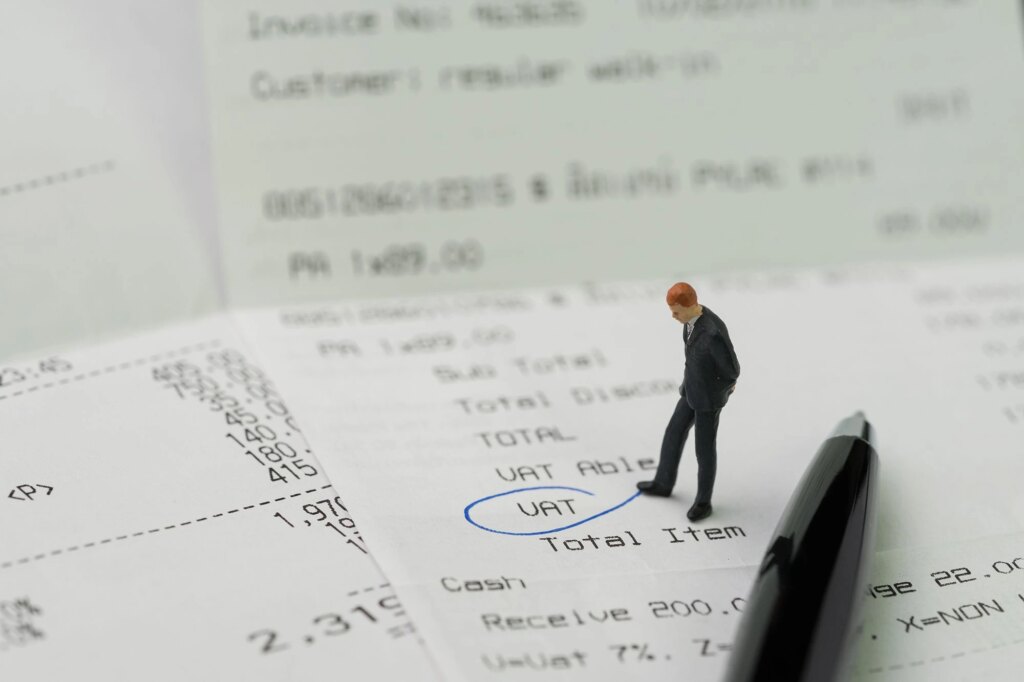
4 Tips for Scaling Your Amazon Business: Capital, Cash Flow, and That Pesky VAT

Table of Contents
Let’s be frank.
Beneath the veil of shiny Instagram-fueled influencer smokescreens, humble-brag personal stories about striking gold with a fifty dollar initial investment, sliding into LinkedIn DMs and all of the other pomp that accompanies networking in the Amazon entrepreneur world, the bottom line is still one thing.
It’s all about the Benjamins..
I’m saying this as someone who, personally and existentially, is very not interested in money beyond its obviously essential role in a currency-based socioeconomic world.
Why, you then ask, are you writing for an Amazon SaaS company in the first place?
(I often ask myself the same, though fortunately or unfortunately, Helium 10 takes good care of its writers, so it’s a bit of a symbiotic relationship).
Money as the root of all evil (and bad jokes) aside, every trail in planning and running your Amazon business leads back to money.
And, no matter where you are on the path to success, no matter how financially savvy (or not) you are, you will at some point encounter pain points related to funding, cashflow, taxes, or something related (if you haven’t already).
These are topics that often come up in our Helium 10 Users Facebook group. Thus, we compiled a handful of useful tips for navigating the world of capital, cashflow, and VATs as they apply to scaling your Amazon business.
A quick look at what we’re talking about here:
- Start with the right amount of capital
- Don’t be afraid to borrow money – wisely!
- Optimize your cashflow
- Expanding internationally? VAT isn’t as scary as you think
After reading, if you want us to delve more into this topic, or if you have other finances-related nuggets you think we should discuss, make sure to leave us a comment!
Now, onwards.
1: Launch a product with the right amount of capital
Just because something is simple doesn’t mean it’s easy. This is one of those times.
There is no “perfect” amount of capital. This number can vary widely simply based on what your product is. After all, the initial investment for an order of a $25/unit item will look very different versus an order for a $200/unit item. Then you have different MOQs, sellthrough rate, and all those other fun things.
We CAN recommend a formula, however. Typically we suggest the cash you start with should amount to 2.5x the cost of your first inventory order.
So, if your first inventory order is going to cost you $1k, you should have $2.5k set aside.
Why this formula?
The logic here is that that amount of cash will provide you with:
- Your first inventory order
- Your second inventory order once your first order starts selling through on Amazon
- Enough leftover for product launch-associated incidentals like PPC bids, professional images, copy, and so on.
(Important! Note that “inventory order” is the landed cost of that order – so not just the manufactured cost of goods, but the shipping costs, import fees, freight forwarding fees, inspection fees, and everything else associated with getting your order to Amazon).
Naturally, the more you start with, the better, because it takes money to make money. But, consider this a good basic measurement.
The more you start with initially, the easier (and quicker) it will be to scale your business up. Starting with too little potentially places a ceiling on your scalability; it’ll be difficult to rise above a certain amount of cashflow.
Still, a burning question might remain: where do you get your hands on that capital to begin with?
Again, most people don’t have several thousands of dollars sitting around gathering dust (and if you do, you’re one of the lucky ones, so get going!).

If you need to scrape together some cash, in the words of Bill Nye the Science Guy, “consider the following.”
2: Don’t be afraid to borrow money – wisely
Lots of new entrepreneurs might balk at the idea of borrowing money. After all, if you’re supposed to be a self starter, shouldn’t you avoid relying on others?
Hogwash, I say! Everyone, at some point, needs to lean on others’ help (and hopefully give that help back to someone else in need later on).
Don’t be ashamed to borrow money wisely – AFTER you’ve gotten your Amazon business going. If you borrow wisely, it’ll be worthwhile.
(We’d like to point out that the borrowing should come after you’ve saved and allocated your initial capital. Don’t borrow money to get started – save up for that part and borrow money later to scale to help with cashflow).
Consider an equity partner. Money is at the heart of many a family feud, but if you know someone conscientious about finances, agree to borrow a certain sum and pay it back with interest after your business has grown. A trusted friend or family member will give you a better rate than any bank.
But don’t forget to treat this like a business deal – because it is. This isn’t a favor from your auntie. Get the terms in writing, and make sure everything’s cool with that relative so, in case the business doesn’t take off, they won’t ostracize you at every Thanksgiving dinner from there on out.
Avoid loan sharks. There are plenty of unscrupulous lenders out there who are aware of the e-commerce boom and looking to take advantage of novice Amazon sellers. Keep an eye on those interest rates and too-good-to-be-true offers.
Consider e-commerce business loans. There are financial tech (fintech) companies out there that specifically offer loans for e-commerce businesses. The opportunities out there are far more flexible and superior to traditional loans.
While viable loan options still remain relatively sparse for Amazon sellers compared to other types of business loans, don’t be discouraged from the option of borrowing money for capital.
At the end of the day, that extra capital will accelerate business growth over being strapped for cash from the outset.
3: Optimize your cashflow
Think of your business as a sprouting plant. It needs to be nourished. If you water it minimally, it will struggle to grow, though it still will, albeit painfully slowly. If you fertilize it, it will grow far quicker and overall be much more healthy.

That same cheesy analogy applies to your business and cashflow. It’s not just the starting capital that matters; it’s also how much cash you inject into your business afterwards.
Take a quick glance at these statistics:
- There are 6 million sellers on Amazon
- Of those 6 million, only 2.5 million of those sellers actually have inventory
- Of those 2.5 million, only about 200k of them are making over $100k a year; this makes up about 3% of sellers
Most of the sellers who failed were because of cash flow mismanagement.
Cash flow issues cause you to run out of stock without backup, which causes sales to plummet and money to be wasted.
It’s a common pain point for Amazon sellers. Amazon only disburses your profits every two weeks (like many traditional pay schedules), and depending on your sellthrough rate, that can make or break you if you aren’t able to allocate the funds for your next inventory order.
That biweekly disbursement is even harder on those selling on a wholesale or arbitrage model. Online and retail arbitrage sellers especially need faster access to cash since they often have to scout and purchase items on an almost daily basis. Clearance sales and similar opportunities aren’t going to wait for your next Amazon paycheck.
That said, you can do a few things to help maximize your cash flow without injecting external cash:
Minimize inventory. Don’t order more than you need. If you overspend on inventory, this harms your ROI meaning it’ll take you longer to get a return. Order just enough inventory to keep stock – generally that’s a buffer of at least 30 days to account for unexpected delays.
(For the record, COVID is a completely unprecedented “unexpected delay” and even 30 days’ cushion probably wouldn’t have covered it … but we’re not talking about COVID-level stuff here).
Once you have a good grasp of inventory management, this will help cash flow as you won’t unnecessarily be tying up extra cash on inventory you don’t need.
Reduce lead times. Find suppliers that can prepare your product faster. Some may have 10-day turnaround times; others may have 3 months. It’s good to shop around, even if you’re already comfortable with your current (but slow) supplier.
Negotiate lower MOQs. Suppliers advertise an expected MOQ, and perhaps you initially adhered to that. These aren’t always set in stone however, and whether it’s a new supplier or one with whom you’ve already established a relationship, you can try negotiating.
Iif the MOQ is too high and each time you’re left with excess inventory that doesn’t sell through in a reasonable amount of time, try to negotiate a lower MOQ with your supplier. Doing so will free up a lot of cash.
Negotiate better payment terms. This is key! Once you’ve established a good relationship with your supplier, you can ask for more favorable payment terms.
Common terms are 30% down and 70% when ready to ship. This is usually not negotiable at the start of your relationship, but once you’ve been friendly you can negotiate less down, or even split into something like 20% down, 30% when ready to ship, and 50% when it arrives in the destination country.
Good suppliers are willing to work with you, and it never hurts to ask. Like lower MOQs, better payment terms frees up cash flow.
4: Don’t be intimidated by VAT if you want to sell outside the US

US sellers are spoiled. Amazon handles the collection of sales taxes on every sale we make, so there’s a lot less red tape we have to deal with firsthand.
VAT (Value Added Tax, or GST in Canada) applies to Amazon marketplaces outside the US, however, and for those not familiar with VAT (aka, most US sellers), the thought of dealing with it can be intimidating. It might even have discouraged you from bothering to explore other Amazon marketplaces.
The quickest solution here is: OUTSOURCE!
There are options and services available out there that cater specifically to e-commerce businesses. Having a service do this will take the guesswork out of the equation for you.
The VAT process is broken down into three simple steps – any reputable service will go through these same steps for you.
Register. Register your business and obtain your VAT number. You need one of these for each specific country/region that you want to sell in (such as one for Amazon UK, one for Amazon DE, and so on). This is done once, much like setting up a business entity and getting an EIN here in the US.
File. This is like filing your taxes. Some regions require it quarterly, yearly, or even monthly – it’s an ongoing thing. Again, this can be easily outsourced.
Pay. Send whatever tax payment is due based on how much you sold and other factors.
It’s really that simple.
Breathe a little easier now
Hopefully this helped demystify some of the often-mind-boggling financial aspects of establishing and running your Amazon business.
Of course, I highly doubt you ever thought it was easy, but for me at least, I find the cashflow aspect of business one of the most intimidating things to understand and manage (and that’s why I’m a writer, and not a financial analyst).
At Helium 10, our goal is, of course, to offer you the most complete suite of tools you’d ever need to manage your Amazon business.
On the money side of things, we have Profits to help you keep an eye on the bigger picture of your … well, profits, as well as ADS to help you manage the monster that is PPC advertising (and all the crazy bidding strategies that come with it).
If you have any of your own questions or insight about cashflow and capital as it applies to your Amazon business, make sure to leave us a comment with your thoughts.
And, as always, keep #CrushingIt!
Achieve More Results in Less Time
Accelerate the Growth of Your Business, Brand or Agency
Maximize your results and drive success faster with Helium 10’s full suite of Amazon and Walmart solutions.

